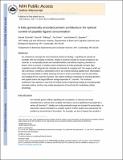| dc.contributor.author | Schmidt, Daniel | |
| dc.contributor.author | Tillberg, Paul W. | |
| dc.contributor.author | Chen, Fei | |
| dc.contributor.author | Boyden, Edward | |
| dc.date.accessioned | 2014-12-16T20:15:52Z | |
| dc.date.available | 2014-12-16T20:15:52Z | |
| dc.date.issued | 2014-01 | |
| dc.date.submitted | 2014-08 | |
| dc.identifier.issn | 2041-1723 | |
| dc.identifier.uri | http://hdl.handle.net/1721.1/92343 | |
| dc.description.abstract | Ion channels are among the most important proteins in biology, regulating the activity of excitable cells and changing in diseases. Ideally it would be possible to actuate endogenous ion channels, in a temporally precise and reversible manner, and without requiring chemical cofactors. Here we present a modular protein architecture for fully genetically encoded, light-modulated control of ligands that modulate ion channels of a targeted cell. Our reagent, which we call a lumitoxin, combines a photoswitch and an ion channel-blocking peptide toxin. Illumination causes the photoswitch to unfold, lowering the toxin’s local concentration near the cell surface, and enabling the ion channel to function. We explore lumitoxin modularity by showing operation with peptide toxins that target different voltage-dependent K+ channels. The lumitoxin architecture may represent a new kind of modular protein-engineering strategy for designing light-activated proteins, and thus may enable development of novel tools for modulating cellular physiology. | en_US |
| dc.description.sponsorship | National Institutes of Health (U.S.) (grant NIH 1DP2OD002002) | en_US |
| dc.description.sponsorship | National Institutes of Health (U.S.) (grant NIH 1R01DA029639) | en_US |
| dc.description.sponsorship | National Institutes of Health (U.S.) (grant NIH 1R01NS075421) | en_US |
| dc.description.sponsorship | National Institutes of Health (U.S.) (grant NIH 1RC1MH088182) | en_US |
| dc.description.sponsorship | National Science Foundation (U.S.) (NSF CAREER Award CBET 1053233) | en_US |
| dc.description.sponsorship | United States. Defense Advanced Research Projects Agency (DARPA Living Foundries, Contract HR0011-12-C-0068) | en_US |
| dc.description.sponsorship | New York Stem Cell Foundation (Robertson Investigator Award) | en_US |
| dc.description.sponsorship | Damon Runyon Cancer Research Foundation (DRG 2095-11) | en_US |
| dc.description.sponsorship | Fannie and John Hertz Foundation | en_US |
| dc.description.sponsorship | National Science Foundation (U.S.) (Graduate Research Fellowship under grant no. 1122374) | en_US |
| dc.description.sponsorship | Massachusetts Institute of Technology. Synthetic Intelligence Laboratory (project) | en_US |
| dc.language.iso | en_US | |
| dc.publisher | Nature Publishing Group | en_US |
| dc.relation.isversionof | http://dx.doi.org/10.1038/ncomms4019 | en_US |
| dc.rights | Article is made available in accordance with the publisher's policy and may be subject to US copyright law. Please refer to the publisher's site for terms of use. | en_US |
| dc.rights.uri | | en_US |
| dc.source | PMC | en_US |
| dc.title | A fully genetically encoded protein architecture for optical control of peptide ligand concentration | en_US |
| dc.type | Article | en_US |
| dc.identifier.citation | Schmidt, Daniel, Paul W. Tillberg, Fei Chen, and Edward S. Boyden. “A Fully Genetically Encoded Protein Architecture for Optical Control of Peptide Ligand Concentration.” Nature Communications 5 (January 10, 2014). | en_US |
| dc.contributor.department | Massachusetts Institute of Technology. Materials Processing Center | en_US |
| dc.contributor.department | Massachusetts Institute of Technology. Department of Brain and Cognitive Sciences | en_US |
| dc.contributor.department | Massachusetts Institute of Technology. Department of Electrical Engineering and Computer Science | en_US |
| dc.contributor.department | McGovern Institute for Brain Research at MIT | en_US |
| dc.contributor.department | Program in Media Arts and Sciences (Massachusetts Institute of Technology) | en_US |
| dc.contributor.mitauthor | Schmidt, Daniel | en_US |
| dc.contributor.mitauthor | Chen, Fei | en_US |
| dc.contributor.mitauthor | Tillberg, Paul W. | en_US |
| dc.contributor.mitauthor | Boyden, Edward Stuart | en_US |
| dc.relation.journal | Nature Communications | en_US |
| dc.eprint.version | Author's final manuscript | en_US |
| dc.type.uri | http://purl.org/eprint/type/JournalArticle | en_US |
| eprint.status | http://purl.org/eprint/status/PeerReviewed | en_US |
| dspace.orderedauthors | Schmidt, Daniel; Tillberg, Paul W.; Chen, Fei; Boyden, Edward S. | en_US |
| dc.identifier.orcid | https://orcid.org/0000-0003-3776-4605 | |
| dc.identifier.orcid | https://orcid.org/0000-0003-0254-4741 | |
| dc.identifier.orcid | https://orcid.org/0000-0002-0419-3351 | |
| mit.license | PUBLISHER_POLICY | en_US |
| mit.metadata.status | Complete | |
